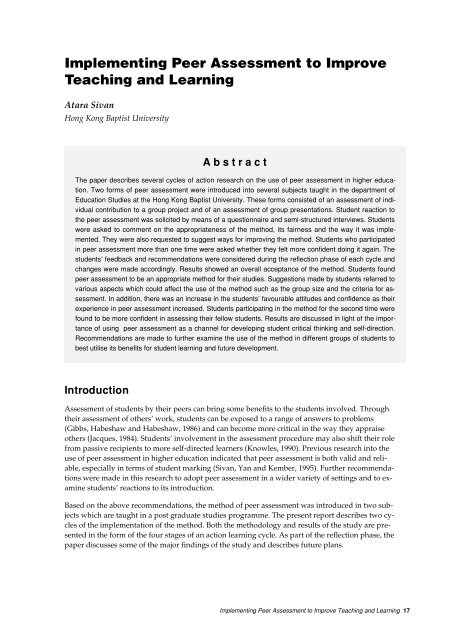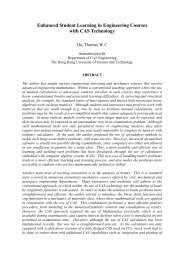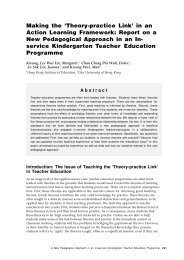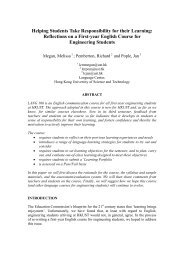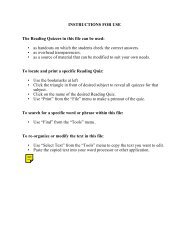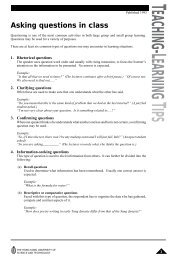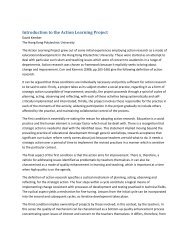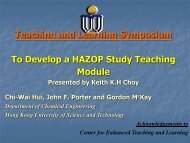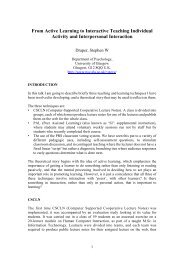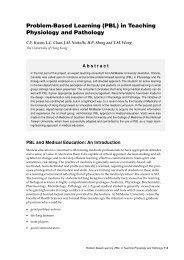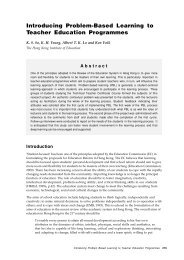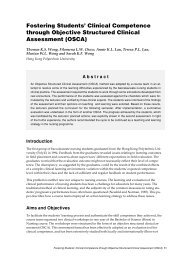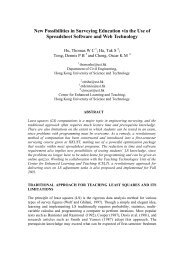Implementing Peer Assessment to Improve Teaching and Learning
Implementing Peer Assessment to Improve Teaching and Learning
Implementing Peer Assessment to Improve Teaching and Learning
Create successful ePaper yourself
Turn your PDF publications into a flip-book with our unique Google optimized e-Paper software.
<strong>Implementing</strong> <strong>Peer</strong> <strong>Assessment</strong> <strong>to</strong> <strong>Improve</strong><br />
<strong>Teaching</strong> <strong>and</strong> <strong>Learning</strong><br />
Atara Sivan<br />
Hong Kong Baptist University<br />
A b s t r a c t<br />
The paper describes several cycles of action research on the use of peer assessment in higher education.<br />
Two forms of peer assessment were introduced in<strong>to</strong> several subjects taught in the department of<br />
Education Studies at the Hong Kong Baptist University. These forms consisted of an assessment of individual<br />
contribution <strong>to</strong> a group project <strong>and</strong> of an assessment of group presentations. Student reaction <strong>to</strong><br />
the peer assessment was solicited by means of a questionnaire <strong>and</strong> semi-structured interviews. Students<br />
were asked <strong>to</strong> comment on the appropriateness of the method, its fairness <strong>and</strong> the way it was implemented.<br />
They were also requested <strong>to</strong> suggest ways for improving the method. Students who participated<br />
in peer assessment more than one time were asked whether they felt more confident doing it again. The<br />
students’ feedback <strong>and</strong> recommendations were considered during the reflection phase of each cycle <strong>and</strong><br />
changes were made accordingly. Results showed an overall acceptance of the method. Students found<br />
peer assessment <strong>to</strong> be an appropriate method for their studies. Suggestions made by students referred <strong>to</strong><br />
various aspects which could affect the use of the method such as the group size <strong>and</strong> the criteria for assessment.<br />
In addition, there was an increase in the students’ favourable attitudes <strong>and</strong> confidence as their<br />
experience in peer assessment increased. Students participating in the method for the second time were<br />
found <strong>to</strong> be more confident in assessing their fellow students. Results are discussed in light of the importance<br />
of using peer assessment as a channel for developing student critical thinking <strong>and</strong> self-direction.<br />
Recommendations are made <strong>to</strong> further examine the use of the method in different groups of students <strong>to</strong><br />
best utilise its benefits for student learning <strong>and</strong> future development.<br />
Introduction<br />
<strong>Assessment</strong> of students by their peers can bring some benefits <strong>to</strong> the students involved. Through<br />
their assessment of others’ work, students can be exposed <strong>to</strong> a range of answers <strong>to</strong> problems<br />
(Gibbs, Habeshaw <strong>and</strong> Habeshaw, 1986) <strong>and</strong> can become more critical in the way they appraise<br />
others (Jacques, 1984). Students’ involvement in the assessment procedure may also shift their role<br />
from passive recipients <strong>to</strong> more self-directed learners (Knowles, 1990). Previous research in<strong>to</strong> the<br />
use of peer assessment in higher education indicated that peer assessment is both valid <strong>and</strong> reliable,<br />
especially in terms of student marking (Sivan, Yan <strong>and</strong> Kember, 1995). Further recommendations<br />
were made in this research <strong>to</strong> adopt peer assessment in a wider variety of settings <strong>and</strong> <strong>to</strong> examine<br />
students’ reactions <strong>to</strong> its introduction.<br />
Based on the above recommendations, the method of peer assessment was introduced in two subjects<br />
which are taught in a post graduate studies programme. The present report describes two cycles<br />
of the implementation of the method. Both the methodology <strong>and</strong> results of the study are presented<br />
in the form of the four stages of an action learning cycle. As part of the reflection phase, the<br />
paper discusses some of the major findings of the study <strong>and</strong> describes future plans.<br />
<strong>Implementing</strong> <strong>Peer</strong> <strong>Assessment</strong> <strong>to</strong> <strong>Improve</strong> <strong>Teaching</strong> <strong>and</strong> <strong>Learning</strong> 17
Methodology<br />
First Cycle<br />
The description of the action learning project on peer assessment starts from an initial reflection<br />
explaining the underlying reasons for implementing this method.<br />
Initial Reflection<br />
The importance of developing student self reliance <strong>and</strong> critical appraisal skills were the underlying<br />
reasons for implementing peer assessment. In the specific context where the method was introduced,<br />
all students were teachers studying in the Postgraduate Diploma in Education Course offered<br />
by the Department of Education Studies at the Hong Kong Baptist University. The use of<br />
peer assessment aimed at encouraging their active participation in the learning process as well as<br />
facilitating the reflective aspect of assessment.<br />
Plan<br />
Plans were made <strong>to</strong> introduce peer assessment in<strong>to</strong> one of the subjects taught in the Postgraduate<br />
Diploma in Education Course. The assessment of this subject comprised two components: course<br />
work (60%) <strong>and</strong> a term paper (40%). A decision was made <strong>to</strong> introduce peer assessment in the<br />
course work component which involved a group project.<br />
Act<br />
In the first cycle, the method of peer assessment was introduced in the subject of ‘Curriculum Studies’,<br />
which is a common core subject offered <strong>to</strong> all students in the first semester of the second year<br />
of their Postgraduate Diploma in Education Course. Two forms of peer assessment were introduced.<br />
Students were required <strong>to</strong> write a project in groups of three <strong>to</strong> five <strong>and</strong> present it <strong>to</strong> the class. In the<br />
first form of assessment, students assessed the overall performance of each group in the presentation.<br />
In the second form of assessment, students within each group assessed the contribution of<br />
their fellow students <strong>to</strong> both the written work <strong>and</strong> the oral presentation. Based on the contribution<br />
ratings, the mark of each individual student was then calculated using a method which was developed<br />
by Goldfinch <strong>and</strong> Raeside (1990) <strong>and</strong> later simplified <strong>and</strong> improved by Conway, Kember,<br />
Sivan <strong>and</strong> Wu (1993). Both forms of assessment were based on a set of criteria using a five point<br />
Likert scale ranging from ‘outst<strong>and</strong>ing’ <strong>to</strong> ‘poor’.<br />
Students were asked <strong>to</strong> assess their groupmates <strong>and</strong> classmates based on criteria which were set by<br />
the lecturer. Each student was given two separate forms. The criteria set for the assessment within<br />
each group referred <strong>to</strong> the level of participation of the individual in six different tasks. These included<br />
the summary of each individual’s work, organisation <strong>and</strong> combination of the individuals’<br />
work, writing the combined group paper, producing a clear explanation in the written description,<br />
organisation of the presentation <strong>and</strong> contribution <strong>to</strong> the presentation. Students were also given the<br />
option <strong>to</strong> add or substitute tasks which they felt were important for their project.<br />
The criteria for assessing the groups’ presentations referred <strong>to</strong> the content <strong>and</strong> context of the presentation.<br />
The criteria were established based on the themes on which students were asked <strong>to</strong> write<br />
their project. In this specific case, the themes related <strong>to</strong> reflection on an existing syllabus with<br />
which students were familiarised. Students were asked <strong>to</strong> evaluate the syllabus in terms of its aims<br />
<strong>and</strong> objectives <strong>and</strong> fac<strong>to</strong>rs affecting its development. Five criteria related <strong>to</strong> the content of the presentation<br />
<strong>and</strong> three criteria related <strong>to</strong> the context of the presentation. Concerning the context of the<br />
presentation, students were asked <strong>to</strong> assess the presentation in terms of its clarity, how interesting<br />
it was <strong>and</strong> also the extent <strong>to</strong> which they unders<strong>to</strong>od the material.<br />
18 <strong>Assessment</strong>
The form for assessing the contribution of an individual <strong>to</strong> the group project was distributed <strong>to</strong><br />
students. They were requested <strong>to</strong> return this form <strong>to</strong>gether with their written projects. To maintain<br />
confidentiality, students were given the option <strong>to</strong> submit the completed form directly <strong>to</strong> the lecturer.<br />
The assessment of each group’s presentation <strong>to</strong>ok place immediately after the presentation.<br />
Observe<br />
The students’ feedback on the peer assessment was examined by means of both questionnaires <strong>and</strong><br />
semi-structured interviews. The following section is a detailed description of the observation<br />
strategies employed <strong>to</strong> solicit student comments on the method of peer assessment.<br />
Questionnaire<br />
A closed questionnaire was used <strong>to</strong> solicit the students’ reaction <strong>to</strong> the method. It comprised eight<br />
statements on the clarity of the forms of assessment, the appropriateness of the method <strong>and</strong> its<br />
fairness. Students responded <strong>to</strong> the statements on a five point Likert-type scale ranging from ‘definitely<br />
agree’ <strong>to</strong> ‘definitely disagree’. The questionnaire also included an additional question on<br />
previous participation in peer assessment <strong>and</strong> an open-ended question about students’ views of<br />
the peer assessment method in general. Students were asked <strong>to</strong> complete the questionnaire.<br />
Interviews<br />
Nineteen students were interviewed <strong>to</strong> shed more light on the appropriateness <strong>and</strong> fairness of the<br />
method, <strong>to</strong> solicit their views on the strategies of implementation <strong>and</strong> <strong>to</strong> obtain their suggestions<br />
for improvement. Participation in the interviews was on a voluntary basis. All interviews were individually<br />
held <strong>and</strong> were conducted by a trained interviewer.<br />
Results of the questionnaire were analysed using the SPSS Statistical Package (SPSS, 1990.) The interviews<br />
were transcribed <strong>and</strong> the transcripts were analysed using the Nudist qualitative analysis<br />
package (Microsoft, Macin<strong>to</strong>sh Aladdin Systems Inc., Raymond Lau, Los Ap<strong>to</strong>s, 1994).<br />
Reflect<br />
The overall return of the questionnaire was 39 out of 50 (78%) in the first cycle <strong>and</strong> 28 out of 29<br />
(96.6%) in the second cycle.<br />
Analysis of the data gathered through the questionnaire showed that overall students accepted the<br />
method <strong>and</strong> thought that they should play part in the assessment. Students also regarded the<br />
method as fair, especially the form of assessment of the contribution of the individual <strong>to</strong> the group<br />
work. Figure 1 shows the mean response <strong>to</strong> each of the statements of the questionnaire.<br />
Answers <strong>to</strong> the open ended question supported the students’ positive views on the method. Of<br />
those who participated in the first cycle, 71.8% had experienced peer assessment before.<br />
Interviews<br />
The follow up interviews held with the students provided an extensive picture about their views of<br />
the method <strong>and</strong> its implementation. The majority of the students agreed in principle with the<br />
method <strong>and</strong> supported its implementation. They regarded it as objective, fair <strong>and</strong> a good mechanism<br />
<strong>to</strong> motivate all students <strong>to</strong> contribute <strong>to</strong> group work.<br />
I certainly appreciate peer assessment. I appreciate the concept <strong>and</strong> the spirit in assessing<br />
others. And, I think peer assessment can in some ways assess the student’s performance<br />
more effectively <strong>and</strong> objectively <strong>and</strong> not only from the teacher’s point of view.<br />
<strong>Implementing</strong> <strong>Peer</strong> <strong>Assessment</strong> <strong>to</strong> <strong>Improve</strong> <strong>Teaching</strong> <strong>and</strong> <strong>Learning</strong> 19
peer assessment <strong>to</strong> me is only an additional <strong>to</strong>ol <strong>to</strong> supplement any defect for drawback of<br />
what we have done. For example, what the lecturer cannot see is how much every member<br />
has contributed, so we give the lecturer another small bit of the picture<br />
I think it is good <strong>to</strong> make the individual work harder <strong>and</strong> contribute <strong>to</strong> the group work <strong>and</strong><br />
not <strong>to</strong> harm the whole presentation of the group.<br />
Although most of the students generally supported peer assessment, some raised concerns with<br />
regard <strong>to</strong> their ability <strong>to</strong> assess their fellow students, pointing out that they were not professional.<br />
These comments were made mainly by students who participated in peer assessment for the first<br />
time. In addition, those students expressed their concern that the objectivity of their assessment of<br />
others may have been affected by personal relationships with their fellow students.<br />
In my opinion, sometimes that may be a concern if those in my group are my friends. I even<br />
know that I may tend <strong>to</strong> give them higher marks. But for those that I don't know, well, I may<br />
be a little bit more objective.<br />
Students indicated that some practical problems existed in the application of the method. These<br />
were included the insufficient time allocated for group presentation <strong>and</strong> the size of the group<br />
which was regarded as <strong>to</strong>o small:<br />
In general, I think that the method of peer assessment is quite fair, but its function is quite<br />
limited for a small group size...it is much better if the group size is bigger. For example, if<br />
the group has about six <strong>to</strong> even eight members , each member of the group will have a more<br />
objective opinion <strong>to</strong> the other group members because the sample size is greater.<br />
Several suggestions were made concerning the ranking procedure <strong>and</strong> the use of certain criteria:<br />
Maybe give a mark <strong>to</strong>tal rather than a mark on every criterion, because everyone’s strength<br />
is different.<br />
I think that the criteria could be developed with the students, although it will depend on the<br />
maturity of the students.<br />
Second Cycle<br />
Plan<br />
Students’ suggestions were considered in the second cycle of action learning. Plans were made <strong>to</strong><br />
involve students in setting the criteria for the peer assessment <strong>and</strong> <strong>to</strong> enlarge the group size.<br />
Act<br />
The second cycle was held during the second semester in the elective subject of ‘Effective Communication’,<br />
which was attended by some students who participated in the first cycle. In this cycle<br />
students were briefed on the method <strong>and</strong> two sessions were dedicated <strong>to</strong> establishing the criteria.<br />
The lecturer shared with the students the previous experience of peer assessment including student<br />
feedback <strong>and</strong> solicited their views on setting the criteria for assessing their classmates. After<br />
brains<strong>to</strong>rming in class, the students arrived at an agreeable set of criteria for assessing the group<br />
presentations. The criteria set by the students included the organisation of the presentation <strong>and</strong> its<br />
relevance <strong>to</strong> the theme under investigation <strong>and</strong> <strong>to</strong> the teacher’s job. Clarity, interaction, timekeeping<br />
<strong>and</strong> presenting in an interesting way were also criteria set by the students.<br />
As for the group size, students could form groups with no limit <strong>to</strong> the size. As a result, there was<br />
one group which consisted of six members.<br />
20 <strong>Assessment</strong>
Observe<br />
Both the questionnaire <strong>and</strong> interviews were used <strong>to</strong> evaluate the second cycle of implementing the<br />
peer assessment.<br />
Reflect<br />
Questionnaire<br />
The overall return of the questionnaire was 28 out of 29 (96.6%) in the second cycle.<br />
Data gathered through the questionnaire showed an increase in the mean response <strong>to</strong> almost all the<br />
statements. Figure 1 shows the mean response <strong>to</strong> the statements on peer assessment in the two cycles.<br />
Of those who participated in the second cycle, 89.3% had experienced peer assessment before.<br />
This rate was higher than that of students in the first cycle.<br />
Figure 1: Student feedback on the peer assessment<br />
Students should play part<br />
in assessment<br />
Fair reflection of own work<br />
Fair division of marks in<br />
group<br />
Fair assessement of own<br />
contribution<br />
Fair assessement of<br />
presentation<br />
cycle 2<br />
cycle 1<br />
Appropriate <strong>to</strong> subject<br />
Assess. B was well<br />
explained<br />
Assess. A was well<br />
explained<br />
1 2 3 4 5<br />
Interviews<br />
Student feedback, which was solicited through interviews, suggested that the involvement of students<br />
in establishing the criteria for their own assessment was highly appreciated by the students.<br />
Comments made by students who participated in both cycles highlighted the implications of involving<br />
them in setting the criteria for assessment:<br />
Last time most of the criteria were set by the lecturer <strong>and</strong> this time, the lecturer invited us <strong>to</strong><br />
set the criteria by ourselves. This is the major difference, because we can voice out our opinions,<br />
which in a sense is good for us.<br />
I think I am more familiar with the criteria <strong>and</strong> what is going on...when we prepared our<br />
presentation, we knew exactly what our presentation should be like, which helps make our<br />
work easier.<br />
If the lecturer himself set the criteria, maybe there are some occasions in which one or two<br />
members do not agree with some of the criteria. If we all agree with some criteria <strong>and</strong> all accept<br />
it, then it is all right <strong>and</strong> makes the assessment more convincing.<br />
<strong>Implementing</strong> <strong>Peer</strong> <strong>Assessment</strong> <strong>to</strong> <strong>Improve</strong> <strong>Teaching</strong> <strong>and</strong> <strong>Learning</strong> 21
One student suggested <strong>to</strong> have additional input from the lecturer <strong>to</strong> the criteria of assessment:<br />
It is pretty good that the lecturer can add one or two criteria so that we can follow <strong>and</strong> think<br />
about what the lecturer requires us <strong>to</strong> do or <strong>to</strong> pay important attention <strong>to</strong> it. If the lecturer<br />
does not talk about the criteria, then we just set it by ourselves, perhaps the lecturer will<br />
somewhat disagree with what we want.<br />
Reactions of students who participated in the two cycles of action learning suggested that their<br />
previous experience in the same forms of peer assessment during the first cycle increased their confidence<br />
in the method.<br />
When I did it first time, I needed longer time <strong>to</strong> think about what grade I should give <strong>to</strong> this<br />
group. Besides, I worried a lot whether I gave a fair mark <strong>to</strong> others. However, I can do it<br />
quite quickly this time...The more you do, better you can do it.<br />
Discussion<br />
The above two cycles of action learning on the implementation of peer assessment showed that<br />
overall it was successful. In both cycles, students were found <strong>to</strong> be in favour of the method. When<br />
compared with results of the previous study where students had not participated in peer assessment<br />
before (Sivan, Yan <strong>and</strong> Kember, 1995), the current level of agreement among the students<br />
seemed <strong>to</strong> be much higher. This finding could imply that previous exposure <strong>to</strong> peer assessment<br />
may contribute <strong>to</strong> students’ confidence in assessing their peers. Moreover, the increase in the favourite<br />
attitudes <strong>to</strong>wards the method during the second cycle may be an indication of an increase<br />
in students’ confidence through participating in the two specific forms of assessment used. However,<br />
this assumption needs <strong>to</strong> be further examined. The support given by the students who participated<br />
in the two cycles <strong>to</strong> the changes made in the strategies of implementation, especially <strong>to</strong><br />
the establishment of the criteria, may have also contributed <strong>to</strong> the effectiveness of the method. The<br />
strategy of involving students in the development of the criteria for assessment can be an effective<br />
channel <strong>to</strong> develop their self-direction <strong>and</strong> thus improve both their learning <strong>and</strong> teaching.<br />
As part of the reflection phase, results of the study were presented in various forums at both Faculty<br />
<strong>and</strong> University wide levels. The method is currently being used in several subjects taught in<br />
the Postgraduate Diploma <strong>and</strong> Master in Education Courses as well as at the undergraduate level.<br />
In the postgraduate courses, students are given the choice of developing their own criteria for assessment.<br />
The method has been approved by the University Course Accreditation <strong>and</strong> Review<br />
Committee as a recognised part of the assessment of the Postgraduate Diploma in Education<br />
Course. Student feedback on the method continues <strong>to</strong> be solicited with the intention <strong>to</strong> further observe<br />
<strong>and</strong> reflect on its contribution <strong>to</strong> teaching <strong>and</strong> learning in higher education.<br />
22 <strong>Assessment</strong>


